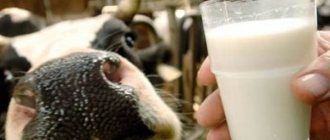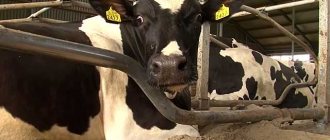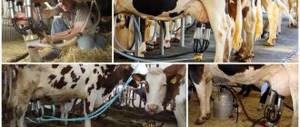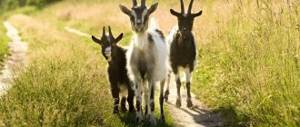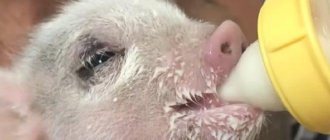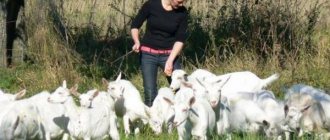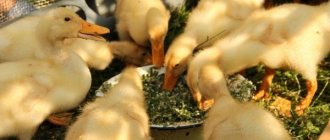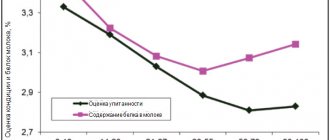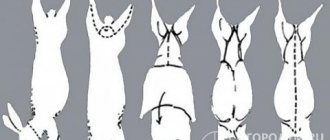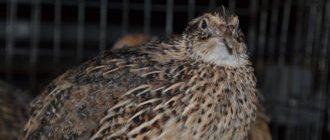What is the fat content of cow's milk?
The volume of fat contained in milk is most often measured on a relative scale, that is, as a percentage of the total mass of the product. For example, an indicator of 3.2% means that the fat in 100 grams of milk is 3.2 grams. In mass production, the concept of total fat content (in weight units) is used.
Fresh milk is the leader in fat content if it is stored at a temperature no higher than +7 ° C and no longer than several hours, after which the fats are broken down into other compounds. The fattest milk is considered to be from the Kholmogory, Kostroma and Sychevsk cattle breeds - the percentage of fat in it ranges from 3.2% to 4.5%, and from Yaroslavl cows - almost 6.0%.
The following factors can affect the fat content of milk:
- breed of cow;
- peculiarities of the content - fattier milk from cattle, which spend most of their time grazing freely;
- feeding ration;
- age – milk reaches its maximum fat content in cows at 5-6 calvings.
In the summer, cows eat more fresh grass and drink large amounts of liquid. Therefore, in winter, milk becomes much fatter. The average fat content of cow's milk is 3.2-4.5%.
Measuring instruments
To check the fat content of milk immediately after milking, farmers with large herds of cattle often purchase a special device - a butyrometer. Such devices are indispensable on large livestock farms that trade in milk. The product in which it is necessary to find out the percentage of fat content should not contain impurities and additives, peroxide and starch, which prolong the shelf life of milk.
Using a butyrometer, you can determine the fat level from 0 to 6%. The device looks like an oblong tube consisting of a narrow and wide part. Once the milk sample is placed in the device, it will need to be heated and separated to separate the components of the product.
See also
Composition and release forms of Felucena, instructions for use for cowsRead
How to use the butyrometer:
- milk is poured into the tube;
- a component required for determining fat content is added – concentrated sulfuric acid. Thanks to the substance, a reaction begins that separates the product into fat and whey parts. At the border of contact between the two environments, a clear boundary is formed;
- isoamyl alcohol is poured in.
The butyrometer must be closed so that during the measurement procedure milk does not leak out of it, stain the laboratory surfaces and personnel clothing, and the loss of the product does not affect the results of the study.
The device is placed in a water bath, which is purchased complete with the butyrometer, and heated to 65-70 oC.
It is important to control the heating temperature using a thermometer so as not to spoil the product or get a false result. Afterwards, the butyrometer is placed in a centrifuge, where, as a result of exposure to milk at 1000 revolutions per minute, it is separated into fat and whey. The result (percentage of fat content) is determined using a butyrometer scale.
Method for determining milk fat content
The need for a technique
The methodology describes a set of methods that can be used to analyze dairy products in the laboratory. It is necessary to perform the work efficiently and correctly.
What is included in the guidelines
The structure of the methodological manual includes:
- introduction;
- theoretical part;
- practical part;
- didactic part
The guidelines include regulatory documents, the use of which will allow you to organize your work in accordance with existing requirements.
Determination methods
There are basic methods used to determine fat content:
- The acid method is the most popular. It shows the fat content, expressing the indicator immediately in mass fractions. The technique is based on the release of milk fat using sulfuric acid and isoamyl alcohol, after which the fat is separated by centrifugation. The calibration of the butyrometer makes it possible to immediately read the fat content.
- The gravimetric method is based on the extraction of fat using substances such as alcohol, ammonia, milk, petroleum and diethyl ether, the solvent is evaporated and the residue is weighed. In parallel with measuring fat in milk, a control experiment is performed with 10 ml of distilled water, using the same reagents. The method is considered effective, but there may be fat loss, for this a control experiment is done.
Milk analyzers are also used; this equipment automatically measures its fat content. It is easy to use and saves time. Before use, check the functionality of the device. Three measurements are taken of distilled water. 20 ml of product is poured into the sample receiver, after all measurements the analyzer produces results.
Getting Results
The test report includes the method used to perform the analysis, the results of the analysis obtained, and any observations that indicate the accuracy of the result is questionable.
SGS Food Laboratory Services
We offer food market participants comprehensive solutions in the field of quality management and food safety. Contact us to discuss how our laboratory capabilities can help your business.
About SGS
The SGS Group is a world leader in independent assessment, inspection, testing and certification. Founded in 1878, today SGS is recognized as a benchmark for quality and business ethics. SGS has over 2,400 offices and laboratories worldwide, employing 95,000 people.
Determining fat content at home
To find out the fat content of milk yourself, you need to prepare a fresh sample of the product and a clean glass, the walls of which are strictly vertical. A mark is made with a marker at a height of 10 centimeters from the bottom of the dish. Milk must be poured into the glass up to the drawn line. If it has time to settle, it needs to be shaken.
The container with milk should be left for 6-8 hours, and then evaluate the result. The cream will be at the very top, and the thinner product will be located at the bottom. The thickness of the creamy layer is measured with a regular ruler - from the top of the liquid to the border with the lower (liquid) milk.
Expert opinion
Zarechny Maxim Valerievich
Agronomist with 12 years of experience. Our best country expert.
Ask a Question
The percentage of fat content is calculated as follows: the thickness of the cream in centimeters is divided by 10 centimeters, the resulting result is multiplied by 100%.
A more complex measurement method requires accurate scales. On the outer surface of the container, in which the settled product has been sitting for several hours in a row, the border of cream and milk is marked. Afterwards, the liquid can be poured into another container. Using a scale, the mass of water is determined, which is then filled with a milk can, to the bottom mark and the volume of water between the marker stripes. To do this, the container (can) itself is initially weighed, then the liquid located between the marks is poured and weighed, and then the rest.
See also
Instructions for use Timpanol for animals, dosage for cows and calvesRead
Next, simple calculations are carried out: the weight of the liquid obtained between the marker lines must be divided by the total mass of water. The resulting figure must be multiplied by 100% - this will be the fat content of the milk cream. Then you need to measure the fat content of the milk. If the fat content of the cream is, for example, 15%, the coefficient will be equal to 0.25. In the case where the volume of the creamy mass is 1% or 2% greater, add 0.01 or 0.02 to the coefficient, respectively. If the mass of cream is less, you need to subtract it from the coefficient.
This can be determined using an example: it turned out that 300 grams of milk accounted for 48 grams of cream. You need to calculate the percentage of cream: 48/300*100%=16. The coefficient of standard creamy fat content is 0.25 (at 15%), add 0.01 to it, you get 0.26. Then you need to calculate the concentration of the milk: 16% * 0.26 = 4.16%.
Precious interest
A milk quality analyzer is an expensive device. The device is also used to determine the fat content of the product. If for industrial turnover or large farms it is an integral part of the business, then if you have one or two cows it is a luxury.
However, for many cattle owners, the question remains of how to determine the fat content of a cow’s milk at home. There are ways that will help you find out about this property without extra costs.
The method is based on the main property of the product – lightness. The fat in cow's milk is in the form of small globules and consists of glycerol and acids. The higher the proportion of fat, the smaller the size of the balls. The viscosity reading increases accordingly. It is thanks to the fat on the surface of the milk that cream is formed. Therefore, the calorie content of the product depends on what percentage.
More on the topic: What can you apply to a cow’s udder to prevent midges?
For example, skim milk contains only 31 kcal per hundred grams, and 1.5 percent milk has 44 kcal. A treat with 2.5 percent fat content has 52 kcal, 3.2 percent has eight kcal more. Next comes 3.5 percent milk with 61 kcal, and in six percent milk the calorie content reaches 84.
To determine the fat content of a cow’s milk at home, you need to do a small and simple trick:
- take clean, dry dishes. It could be a glass or a jar;
- Pour a little milk into the container, up to the curved area if using a can;
- after this you need to measure the distance from the bottom to the liquid level. The interval should be exactly ten centimeters;
- place the milk in a dark place at room temperature;
- leave the container for eight hours.
After the specified time, cream will begin to appear on the surface. Their quantity will help check the fat content of domestic cow's milk. The layer of cream is measured with a ruler. Each millimeter is equal to one percent fat content. If three millimeters of cream appears during the specified time, then the fat content of the milk corresponds to three.
Of course, it is impossible to talk about the absolute reliability of such a simple method. After all, when measuring, the density of the cream is not taken into account. It is directly dependent on the animal’s nutrition, season, genetics and other indicators. But you can find out approximately how much fat content cow’s milk has.
Igor Nikolaev
auto RU
An alternative to this method is a similar one, but using scales.
Take the settled milk and cream and mark the boundary between them with a pencil. You need to outline the border of the milk, the border of the beginning and end of the cream. Everything is poured into another container.
After this, the weight of water is measured to the level of the very first mark from the bottom, then part of the water between the marks. This will become clear as you add it. For more accurate calculations, the can is weighed separately and then all together with the subtraction of the tare weight.
Finally, the weight of water between the marks is divided by the total mass of liquid, the figure is multiplied by one hundred percent. This is how the percentage of cream is calculated, the amount of which is proportional to the fat content. For example, with 15 percent cream the fat content is 0.25. Next, the amount of cream as a percentage is multiplied by the fat content factor.
You can also resort to tables with information about animal breeds under equal nutritional and maintenance conditions. Breeds that produce high-fat milk live mainly in foreign countries. There, breeders reach fat milk production through experiments within the herd over many years. But this form will give an even more relative result than the previous two.
What can affect the final fat content?
It is important to consider that the percentage of dairy products can be increased under several conditions:
- the thinnest are the first streams of milk milked from the udder. They contain only 1% fat;
- The last (hind) milk is the thickest;
- fatter and thicker milk in cows fed with balanced feed during the dry period - if the farmer prepares feed for cattle enriched with vitamins, minerals, proteins, fats and carbohydrates.
Depending on the breed, the milk will also have more or less fat. Typically, cows that produce less milk will have more concentrated milk and vice versa.
Throughout the summer, cows are grazed on pastures, so the milk acquires not only natural concentration, but also positive taste qualities, as well as a pleasant creamy shade. In winter, to maintain fat content at the proper level, cattle must be fed a balanced diet - hay, grass meal, silage, vegetables, porridge with boiled root vegetables and vegetables.
